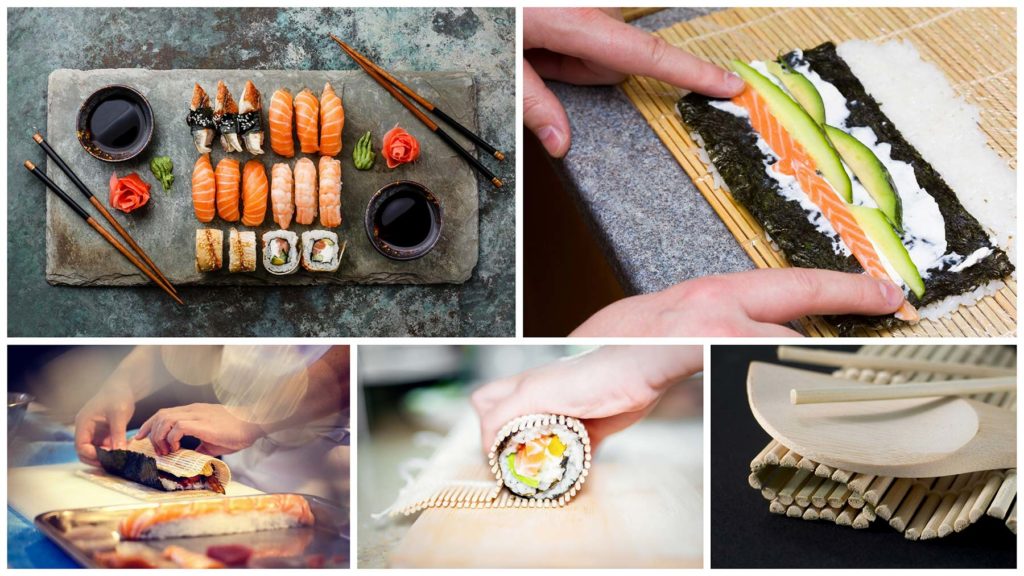
Japanese cuisine: how to make great sushis
Discover the art of preparing perfect sushi with our complete guide. Techniques, tips and secrets for a culinary journey to the heart of Japan.
Sushi is much more than a simple dish; it’s an essential facet of Japanese culture and history. This culinary adventure began around the 8th century, when sushi was first and foremost a means of preservation. Originally, fish was fermented with rice, a technique borrowed from China, which evolved over the centuries to become the delicate art we know today.
It wasn’t until the Edo era (1603-1868) that sushi began to take on the form we know today. The “narezushi”, ancestor of modern sushi, gave way to the “hayazushi”, the quick sushi, emphasizing freshness rather than fermentation. Tokyo (then Edo), with its abundant access to fresh seafood, became the cradle of contemporary sushi, in particular nigiri-sushi, a bite of seasoned rice topped with a slice of fish.
Beyond their flavor, sushi represents elegance and simplicity, two pillars of Japanese aesthetic philosophy. Each piece of sushi is a work of art in itself, reflecting the skill and precision of the sushi chef. In Japanese culture, the preparation of sushi is seen not only as a craft, but also as an art form requiring years of practice and dedication.
Originally a local dish, sushi conquered the world in the 20th century. Its international popularity exploded, thanks in part to its unique taste, meticulous presentation and perception as a healthy meal option. Sushi restaurants have sprung up in every major city in the world, from high-end establishments to accessible chains, testifying to its acceptance and integration into diverse culinary cultures.
Key ingredients for sushi
Sushi rice (Shari): The Sushi Foundation
Rice is the heart and soul of sushi, an ingredient so crucial that it can make or break the quality of the dish. Sushi rice, known as shari, must be of the japonica type, characterized by small, round grains that become sticky when cooked. This sticky texture is essential for the rice to maintain its shape, whether in nigiri or maki rolls.
The choice of rice is a question of quality and flavour. Premium varieties such as Koshihikari rice are highly prized for their perfect balance between sweetness and stickiness. During preparation, the rice is seasoned with a blend of rice vinegar, sugar and salt, giving each grain a subtle taste and a light sheen, while highlighting the delicate flavor of the fish.
Fish & Seafood: The Star of Sushi
The selection of fish and seafood is a matter of freshness and quality. Popular varieties include tuna (maguro), rich and flavorful, and salmon (sake), renowned for its smooth texture and delicate taste. Other popular choices include eel (unagi), octopus (tako) and shrimp (ebi).
Freshness is paramount. Sushi chefs look for fish with clear eyes, firm flesh and a marine smell, with no unpleasant aromas. Cutting the fish is an art in itself, with each slice prepared to maximize texture and flavor, while presenting an attractive appearance.
Seaweed (Nori): The Edible Packaging
Nori seaweed plays a key role in the preparation of maki and temaki (hand rolls). These dried seaweed leaves are appreciated for their crunchy texture and umami taste. There are different qualities of nori, ranging from thicker, tastier sheets to finer, more delicate varieties, each bringing a unique dimension to sushi.
Wasabi, Pickled Ginger, Soy Sauce: Indispensable Accompaniments
These condiments play a crucial role in the sushi experience. Wasabi, a pungent green paste, is traditionally used to add a spicy touch that enhances the taste of the fish without masking it. Pickled ginger, often pale pink, is used to cleanse the palate between bites of sushi, offering a slightly tangy touch. Soy sauce, meanwhile, is used as a dip, adding a salty, umami dimension. It’s important to use it sparingly so as not to overwhelm the delicate flavours of the sushi.
Together, these ingredients form the basis of the art of sushi, each playing a distinct role in creating a harmonious balance of flavors and textures. Mastering their use is essential for any aspiring sushi chef.
Tools needed to make good sushi
Special Sushi Knives: Types and Care
Preparing sushi requires a set of specialized knives, each designed for specific tasks. The most iconic is the yanagiba, a long, thin knife ideal for slicing fish for nigiri and sashimi. Its unique blade enables clean, precise cuts, essential for preserving the texture of fish. Other important knives include the sturdier deba, used for slicing and filleting fish, and the usuba, a rectangular knife for cutting vegetables.
Maintenance of these knives is crucial. They need to be sharpened regularly to maintain their optimal cutting edge, and hand-cleaned after each use to preserve their quality. Experienced sushi chefs take particular care with their knives, regarding them as extensions of their hands.
Bamboo mats (Makisu): Use for Makisu
Bamboo mats, or makisu, are essential for rolling maki. These flexible mats enable rice and ingredients to be rolled and pressed into a compact, uniform shape. To use a makisu, the nori is placed on the mat, followed by the rice and other ingredients. As the mat is rolled, uniform pressure is applied to form the roll. Makisu can also be used to form other types of sushi, such as temaki (hand rolls).
Maintenance of makisu is also important. It should be cleaned and dried thoroughly after each use to avoid any build-up of bacteria and ensure a long service life.
Other useful sushi-making accessories
A number of other tools are also useful for making sushi:
- Rice cooker: An electric appliance or pan specially designed to cook sushi rice perfectly. A rice cooker guarantees even cooking and facilitates the process, especially for large quantities of rice.
- Fish tongs: Used to remove fish bones. It is more precise and delicate than fingers or other tools.
- Hangiri: A flat wooden container used for cooling and seasoning rice. Its wooden surface helps absorb excess moisture and distribute the seasoning evenly.
- Fan: Used to cool rice quickly after adding seasoning. This helps give the rice its ideal glossy, sticky texture.
Each tool in a sushi chef’s arsenal is chosen for its ability to improve the precision, efficiency and quality of the sushi prepared. Mastery of these tools, combined with knowledge of the appropriate techniques, is fundamental to any cook aspiring to excel in the art of sushi making.

Basic sushi preparation and techniques
Sushi Rice Preparation: The Art of Perfection
Preparing sushi rice is a meticulous process that demands patience and precision. It all starts with washing the rice, an essential step to remove excess starch and ensure the perfect texture. The rice is carefully washed several times in cold water until the water runs clear, then left to soak for a short time before cooking.
Rice is usually cooked in a pressure cooker or saucepan, following a precise ratio of water to rice. Once cooked, the rice is transferred to a hangiri (a flat wooden container) where it is seasoned with a mixture of rice vinegar, sugar and salt. This step must be carried out with care, fanning the rice while incorporating the seasoning to cool it to room temperature while giving it a glossy, sticky texture.
Fish-cutting techniques: Precision in action
Cutting fish is a fundamental aspect of sushi preparation, requiring great skill and extreme precision. Experienced chefs use knives specially designed for sushi, such as the yanagiba, to obtain thin, even slices. Each type of fish is cut at a specific angle and using a specific technique, depending on its texture and consistency.
The cut must be clean and burr-free, achieved in a single, fluid movement. This not only preserves the delicate texture of the fish, but also enhances its freshness. A good cut also influences the way the fish marries with the rice, affecting the overall taste experience.
Sushi assembly: Nigiris, Makis, Sashimis
Sushi assembly is a balancing act between form, texture and taste.
- Nigiris: These sushi dishes consist of an oval rice ball, on which a slice of fish is placed. The rice should be slightly compacted so that it stays together, but not so tightly that it becomes mushy. The fish slice is often lightly coated with wasabi between it and the rice to add a subtle heat.
- Makis: For these sushi rolls, the rice and ingredients are wrapped in a sheet of nori. They can be made with a bamboo mat (makisu), allowing a tight, even roll. Makis can be cut into pieces or served in rolls, depending on style.
- Sashimi: Although technically not sushi (because it’s rice-free), sashimi is an integral part of the sushi experience. It consists of finely cut slices of fish or seafood, aesthetically presented.
Every step of the assembly process is crucial, requiring meticulous attention to detail. The size of the pieces, the proportion between rice and fish, and the overall presentation all contribute to the sensory experience of sushi, making each bite both visually appealing and tastefully satisfying.
Cooking times and specific considerations for good sushi
Cooking rice: Mastering time and method
Cooking sushi rice is a critical step that requires precise control of time and method to achieve the ideal texture. Typically, sushi rice is cooked with a ratio of approximately one part rice to one part water. This ratio may vary slightly according to rice type and personal preference.
A pressure cooker or saucepan with a tight-fitting lid is often used for cooking. The rice is first brought to the boil, then the heat is reduced to allow cooking over a low heat. Total cooking time is usually between 18 and 20 minutes. After cooking, it is essential to let the rice rest for about 10 minutes, covered, to allow final moisture absorption and even cooking.
Seafood preparation: Light cooking and marinades
Although many sushi dishes use raw fish, certain types of seafood require specific preparation, which may include light cooking or marinades.
- Light cooking: Some varieties of seafood, such as shrimp (ebi) or octopus (tako), are briefly cooked to ensure a tender texture and optimal taste. Cooking is generally done by blanching or steaming, just enough to cook the seafood while retaining its juicy texture and delicate flavor.
- Marinades: Some sushi preparations involve marinating seafood to enrich its flavor. For example, mackerel (saba) is often marinated in vinegar to soften its robust flavor and preserve its freshness. Marinades vary from simple blends of vinegar and salt to more complex compositions with herbs and spices.
These preparation methods add depth and variety to sushi, offering textures and flavors that contrast and complement traditional raw fish. Each technique requires specific know-how to ensure that the seafood is prepared in a way that enhances its unique qualities, while integrating harmoniously with the overall sushi.
Tips and Tricks for Perfect Sushi
Tips for Beginners: Avoiding Common Mistakes
Don’t overhandle the rice: Sushi rice should be handled with care and delicacy. Pressing too hard can make the rice mushy and too dense.
Keeping hands moist: Wet hands lightly when handling rice to prevent sticking.
Balance flavors: Be careful not to overload sushi with toppings. The idea is to maintain a balance between rice, fish and side dishes.
Use quality fish: Choosing fresh, high-quality fish is crucial for safety and taste.
Tips for Better Flavor and Texture
Season rice with precision: Rice must be seasoned with the right balance of vinegar, sugar and salt. This greatly influences the final taste of the sushi.
Cut the fish in the right direction: The cut of the fish should follow the grain of the flesh. This guarantees a mouth-watering texture and aesthetic presentation.
Temperature of rice and fish: Serve sushi with the rice at room temperature and the fish slightly chilled. This temperature difference enhances the taste experience.
Chefs’ secrets for exceptional sushi
Controlling rice cooking time: Perfectly cooked rice is the key. It should be neither too hard nor too soft.
Preparing fish: Experienced chefs know how to handle every type of fish, whether lightly marinating, cooking or maturing, to bring out the best flavor.
Creative presentation: The visual aspect of sushi is just as important as the taste. Chefs use their creativity to arrange sushi attractively, playing with colors and textures.
Judicious use of condiments: Wasabi, ginger and soy sauce should be used sparingly to complement rather than mask the delicate flavors of sushi.
Innovation and respect for tradition: While respecting traditional methods is crucial, the most renowned sushi chefs are not afraid to experiment with new ingredients and techniques to create unique taste experiences.
